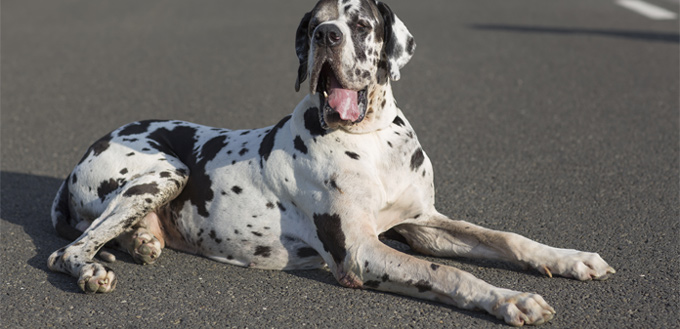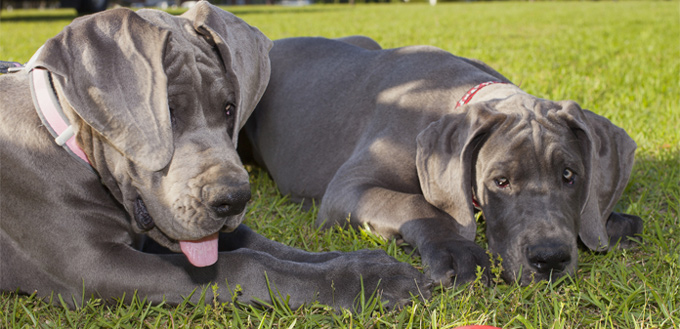The Great Dane is majestic yet easy-going, courageous and spirited, but never timid. These are just some of the innate characteristics that make the Great Dane such an invaluable man’s best friend. Its unique physical and mental combination gives the breed a grandeur that one can never see from other dog breeds.
Called the “Apollo of Dogs”, the Great Dane is a pure bundle of joy. Despite its hulking size, it is always a pleasure to be in the company of these gentle giants. Its imposing size notwithstanding, would-be intruders would think twice. Yet despite its strength, its gentle nature is matched only by its unquestionable commitment to its family.
There have been many stories about Great Danes doing many remarkable feats yet perhaps the one characteristic that always sticks to the minds of many is that it is a scaredy dog, no thanks to the most famous GD of them all, Scooby Doo. Scooby may be skittish when it comes to ghosts but no one can ever deny that he has saved the gang more than once. This is the classic Great Dane – ever-loyal, dependable, and very friendly dog.

Its size does come with quite a few health concerns, though. They’re huge, but they’re small when it comes to longevity. Many don’t even last to see a decade with their families, maxing out at 7.5 years on average.
But if you do manage to get a Great Dane for your family, love it well and shower it with affection. Teach it as it is still considered a working dog. It may not last 10 years, but avid fans of the breed can tell you honestly that this is one breed you’d happily have for your family.
Quick Facts
- Contrary to popular belief, Great Danes are not dogs bred from Denmark. Instead, these gentle giants are Germans in origin. The name ‘Great Dane’ is the English equivalent to the dog’s French name – “le Grande Danois”. Literally, this means “Big Danish”. It was coined by Georges-Louis Leclerc, Comte de Buffon in the early 18th
- Considered the Apollo of the dog kingdom, the Great Dane was initially bred for guarding their master’s property and hunting large game. They are also believed to be very useful in times of war. Today’s Great Danes have shed their feisty character in favor of calm and friendly demeanor.
- Have you ever wondered what type of dog is Scooby Doo? Yep, it’s the Great Dane, the largest lap dog in the world, known to love snuggling up to their human masters despite his gigantic size.
- The tallest dog in the world is a Great Dane. Zeus stands 4 inches short of 4 feet when on all fours. Standing on its hind legs and Zeus is only 4 inches shorter than ex-NBA player Yao Ming. On average, however, it’s the Irish wolfhound that is considered the tallest among canines.
- Despite their size Great Danes make the perfect pet for apartment dwellers. They still need room to sprawl and roam around, though.
- Great Danes may have exceptionally long limbs, but their lifespan is relatively short, averaging only about 7.5 years. Zeus died at age 5 because of its massive size’s impact on its aging body.
- Great Danes may be known for their gentle character, but their bravery and wit is incomparable especially when it comes to protecting their family. Juliana, a Great Dane, was a recipient of two Blue Cross medals during the Second World War. In 1941, a bomb fell into the very house Juliana was living in. She peed on the bomb, defusing it, and earning for Juliana her first medal. Three years later, Juliana alerted authorities to a raging fire that was slowly gutting the shoe shop of her owner. This gave Juliana her second Blue Cross.
- A male Great Dane can grow anywhere between 30 and 34 inches, although the current breed standard sets it at a minimum of 30 inches, but preferably 32. The female Great Dane can grow from 28 inches to 32 inches. Males can weigh between 140 and 175 pounds while females can weigh between 110 and 140 pounds.
Temperament
The Great Dane is a highly dependable dog. It is friendly, courageous and spirited. It is one of the most easygoing breeds of dog, despite its imposing size. It is very friendly and affectionate especially with its family and displays unparalleled self-confidence in the company of strangers. It’s sweet and gentle and loves nothing more than to play with kids. Unfortunately, their gigantic size makes them quite dangerous for young kids. Older children and teenagers will find these gentle giants to be the perfect life-sized stuffed toy they’ve been dreaming of.
Its easy-going and stable nature makes the Great Dane an ideal breed to have in small spaces, perhaps even in apartments. It won’t mind lounging the whole day especially when its loved one is nearby.
The quintessential lap dog, the Great Dane puppy takes this characteristic to a whole new level. It will never leave your feet until you’ve given it a warm cuddle. It will easily jump on you and lay down on your lap until it dozes off to oblivion.
Things You Should Know
The Great Dane may be great for the family, but it still requires certain things to thrive. These dogs are primarily bred for hunting through the ages. It is only about 400 years ago that gentleness had been carefully bred into them. If you’re entertaining the idea of getting one of these dogs into your home, there are certain things you ought to know:
Trainability
The Great Dane’s desire to please is intense, making it super easy to train. However, it is important that socialization and training start early in life. They may not be as intelligent as other dog breeds, but their desire to gain their master’s approval and affection underscores their willingness to learn
Because Great Danes are good-natured, it is important that socialization be started at the earliest possible time. They need to be exposed to all the things that can help them gain that admirable reputation of being highly sociable. From different people to different experiences, GD puppies will learn that all of these are important aspects of their existence.
Most pet parents of GDs enroll them in puppy kindergarten classes where they learn to socialize with fellow young GDs and other breeds. Inviting guests and visitors to your home can also expose them to the very nature of human interactions. Taking a Great Dane to busy parks as well as commercial establishments that allow dogs can also help expose these dogs to everyday life. Taking it for a walk all over the neighborhood will also introduce it to folks and other dogs in your area.
Grooming
Great Danes have relatively short coats. However, it is remarkably smooth for its size. GDs come in 6 different colors: fawn, brindle, black, harlequin, blue, and mantle. GDs are great shedders. But you don’t really need to worry since its coat is quite easy to maintain. Using firm-bristled brush can help maintain the integrity of its coat. Regular brushing should also help minimize the need for frequent bathing. You can just imagine bathing a giant that might not even fit inside your bathtub. Doing this on a more frequent basis will definitely take its toll on you and your resources. It’s like having a miniature cow in your home.
GDs require frequent brushing of the teeth. Experts recommend brushing at least three times a week as they are especially prone to the development of tartar and plaque. Ideally, however, daily toothbrushing should help prevent gum disease while also eliminating bad breath in dogs.
As for your Great Dane’s nails, nail trimming is needed once or even twice every month. While this is not absolute, you can take your cues from any clicking sound that you may hear emanating from its claws every time it walks. This should be your sign that it’s time for a nail trimming session.
You May Also Like: Dog Nail Clippers & Grinders

Health Issues
Great Danes are traditionally healthy dogs because they were especially bred for work, hunting bears and boars. Unfortunately, the shift in their breeding purpose has somehow led to the development of a variety of health problems that are more common in this breed of dog than others.
Great Danes are especially vulnerable to gastric torsion which can start out as bloating. This is a condition that is not exclusive to GDs, however, as it is fairly common in large and deep-chested breeds. What happens is that dogs that are fed a single large meal, drink large amounts of water, eat very rapidly, or even exercise vigorously right after meals tend to produce gas in their stomachs. Over time this can lead to twisting of the stomach, a condition called gastric torsion. This is always considered as a medical emergency as the blood supply to the stomach and the small intestines can be cut off. This prevents the normal blood flow back to the heart and can lead to a reduction in blood pressure and the eventual occurrence of hypovolemic shock.
In addition to gastric torsion, Great Danes are also prone to hip dysplasia whereby the bones of the thighs don’t really fit that well into the hip joint. This can least to pain with movement or even lameness. If not corrected immediately, canine arthritis can develop. Considering that these dogs can weigh up to 170 pounds, their weight can also put a significant strain on their joints.
Great Danes are also susceptible to osteosarcoma, dilated cardiomyopathy, tricuspid valve dysplasia, mitral valve defects, patent ductus arteriosus, and subaortic stenosis. There are other health conditions that may affect a Great Dane. This highlights the need for taking puppies only from credible Great Dane breeders who can guarantee you that their puppies don’t have any genetic abnormality.
The Great Dane is an excellent choice for a pet if you are someone who wants a dog that is:
- Very friendly and affectionate with its family, especially kids as well as other dogs
- Self-confident in the presence of strangers
- Easy to groom
- Easy to train
- Devoted and committed to its family
- Reserved yet very confident
- Loving and gentle
- Very elegant and has an air of magnificence in its mere presence
Unfortunately, a Great Dane is not for you if you:
- Have a very small amount of floor space
- Don’t recognize the importance of early puppyhood training and socialization
- Cannot spend enough time with your dog especially for its exercise and playtime needs
- Are going to leave your dog for extended hours every day
- Don’t like a pet that drools heavily
- Don’t like a giant breed of dog
History
Scooby Doo may be a 1969 creation, but his forebears date as far back as the 14th and 13th centuries BC in ancient Greece. Frescoes from Tiryns depicted large boarhounds that uncannily resemble the modern Great Dane. As the name implies, boarhounds are dogs that are specifically bred for hunting wild boars. They continued to appear in ancient Greece. In 3000 BC Egypt, the same large dogs were observed in Egyptian monuments. The dog was also observed in other cultures like that of China, Tibet, and Denmark. It is perhaps the latter that stuck with the breed especially when one considers the 7 skeletons of extra-large hunting dogs currently on display at the University of Copenhagen Zoological Museum.

By mid-16th century European nobility imported long-legged and strong hunting dogs from England. These dogs were the direct descendants of crossbreeds involving Irish Wolfhounds and English Mastiffs. The German nobility called them Englischer Hund. They were bred specifically for the purpose of hunting bears and boars. Unfortunately, with the increasing use of firearms in hunting, these dogs fell out of grace. However, being the preferred hunting dogs of the European nobility and aristocracy, they were bred for companionship.
In 1755, Georges-Louis Leclerc, Comte de Buffon wrote in his ‘Histoire naturelle generale et particuliere’ about the regal demeanor of these giant dogs. Leclerc called them “le Grande Danois” having first observed them during one of his trips to Denmark. Translating the French phrase into English paved the way to the naming of the breed as the Great Dane, although technically it is a German dog.
Far detached from its glorious days as a large-game hunter, the Great Dane has morphed into one of the dog world’s most-loved breeds. Take good care of this gentle giant and it will reward you with its loyalty, friendliness, and affection.
Sources:
- Great Dane, The American Kennel Club
- Sarah Thornton, Great Dane Can Fnally Stretch His Long, Long Legs, Best Friends Animal Society





